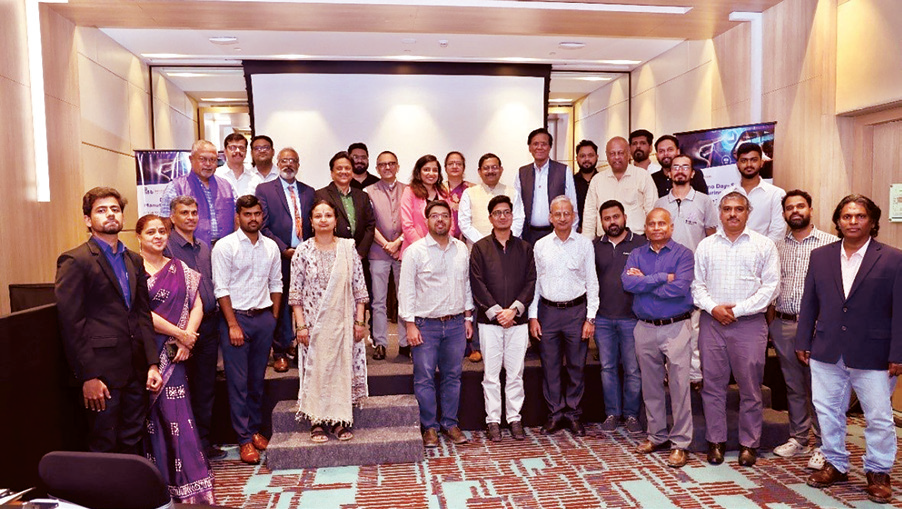.jpg)
As rich as it can get
Ajrakh of Kutch, a 3,500-year-old resist dyeing and textile printing technique, is the recent addition from Gujarat to the list of prestigious GI-tagged fabrics.
“It’s a proud moment for India’s rich textile heritage, as GI comes after a long process of documentation and verification. It reminds us to appreciate and support other indigenous fabrics which have stood the test of time,” says Padmaja Sakhamuri, committee member of the Crafts Council of Karnataka, and Convener, Vastrabharana, an annual exhibition of weavers’ exclusives.
Ajrakh, the hand block art and craft print, has its roots in the Khatri family based at Ajrakhpur at Kutch in Gujarat, whose ancestor in the 16th Century came to India from Sindh bringing back the craft of Ajrakh.
The art has rekh resist printing applied to both sides of the cloth, followed by some painstaking stages in its procedures that have its organic makeover helping one wear them on both sides.
Designers are incorporating many such heritage block printing, weaving and embroideries into their collections bringing in a culture and craft resurgence.
From sarongs to saris!
Bharathy Harish, designer and head of Madhurya, a textile revival boutique, says GItag to Ajrakh is another fillip to the age-old art. The history of Ajrakh has been traced to the Indus Valley Civilization.
“Recognizing such historic block prints can also help preserve cultural heritage and craftsmanship that are often intertwined with local histories and identities. Ajrakh lungis (sarongs), pagadis (turbans) and a shoulder throw were used by cattle herders then, and today in the Ajrakh evolution we have dress material, stoles, dupattas and saris, not to forget the Ajrakh fabric used in patchwork quilts!” adds Bharathy.
Ajrakh and khadi Delhi-based textile artist Shelly Jyoti has been tirelessly working on Khadi, her inspiration being ‘Gandhiji’s Charkha movement’ that had called for boycotting foreign cloth for self-sustenance during India’s freedom struggle to underline the potency of economic independence.
“Gradually I tried out Ajrakh's integration into Khadi textile art, adorned with intricate charkha designs. My effort showcases creative fusion while holding on to cultural roots,” she explains showing some of her Ajrakh-on-khadi pieces during a textile exhibition.
Sustainability being her basic foundation, Shelly’s fashion line attempts to bring in narratives from historical influences and contemporary themes.
“I design garments that convey a meaningful history. I do this by reviving traditional textile techniques or experimenting with innovative materials,” she says recollecting her tryst with Ajrakh that paved a new path to her textile perception.
Shelly Jyoti after studying English literature, took formal training in fashion design and clothing technology. In 2008, while researching on the indigo dye, she landed at Bhuj in Gujarat, where she discovered Ajrakh.
“In the village of Ajrakhpur, at the house of Ismail Khatri, one of the renowned, ninthgeneration Ajrakh printers, I learnt that Ajrakh is the Arabic word for indigo, one of the world’s oldest block printing techniques. I was mesmerized to see the process and designs,” Jyoti had recalled during her exhibitions at NGMA and IGNCA in Bengaluru.
The Khatris or the Ajrakh craftsmen migrated from Sindh and Balochistan (now in Pakistan) in the 16th Century CE when the then King of Kutch invited them to settle down in the region and pursue their profession.
According to textile scholars and historians, initially the Khatris settled in the Kutchi village of Dhamadka, and in the aftermath of the 2001 earthquake, they had to move from Dhamadka to Ajrakhpur, a more recent settlement of artisans.
Their documentation also has brought in an ‘Egypt connection’ when fragments of Ajrakh prints were found in Fustat, Cairo’s first Islamic settlement.
Protracted process
Why is Ajrakh said to be laborious? “It involves nearly 20 stages in its creation,” says Shelly.
“The fabric is washed, printed and dried innumerable times to succeed in having the intricate patterns emerge in indigo, madder and other colours, including black and white that outline the motifs. It’s compounded because of the resist printing technique that is done with carved wooden blocks. The blocks are dipped in a paste of gum, lime and herbs and sealed onto the cloth so that it resists the dye and the patterns emerge once the paste is washed off.”
Blocks are recognized with their names according to their design. “Like the motif ‘gurda-kaleji’ (kidney & liver) that are kidney shaped,” explains Shelly whose widerange of textile works also include the Gandhian philosophy-and-Ajrakh combo to address modern tastes.
Her appeal to urban Indians is “to connect” with the difficulties of rural livelihood and support these handmade crafts.
“There is a critical environmental situation these regions in Gujarat are staring at. It’s a water-crisis that the Ajrakh artisans are battling, and asking for better water distribution methods as it takes 13 litres of water to produce one metre of fabric,” she rues.
Did you know….
- Ajrakh was initially a functional garment cloth, quite in contrast to its present opulent status. Egypt took to its high quality of colour-fast dyes and intricacy of designs
- Multiple stages of washing, drying and dyeing are involved in producing a true Ajrakh
- A genuine Ajrakh can never lose colour as it has journeyed through several rounds of washing during its making
 English daily published in Bengaluru & Doha
English daily published in Bengaluru & Doha






